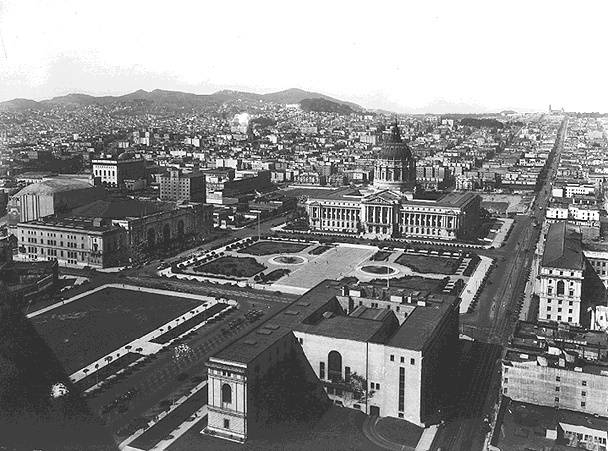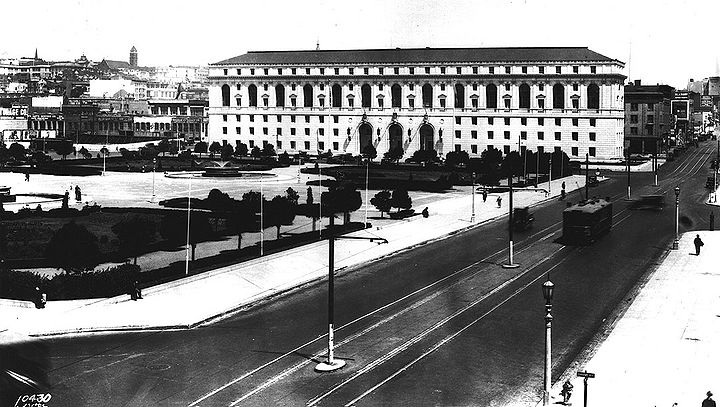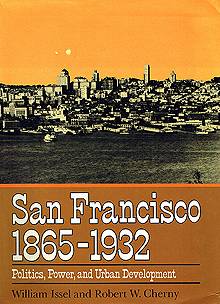Mayor Rolph and the New Civic Center
Historical Essay
by William Issel and Robert Cherny
New City Hall, shown here around 1930, with the Civic Auditorium at left and Main Library lower right.
Photo: Private Collection, San Francisco, CA
The most dramatic of these PPIE-related undertakings was unquestionably the development of the new Civic Center. The first proposal for creation of a Civic Center appeared in 1899, incorporating the city hall just completed, the new federal building on Seventh Street between Mission and Market, and the auditorium of the Mechanics' Institute. Daniel Burnham drafted an ambitious city plan in 1905 and revised it in 1909. Both envisioned monumental civic centers. Even though the city clearly required a new city hall to replace the one that collapsed in the earthquake and fire, a bond issue to build one failed to win approval in 1909. When Rolph took office as mayor in 1912, nearly six years after the earthquake and fire, San Francisco did not have a permanent city hall, had no plans for one, and had no financial capability to build one.(14)
In his 1911 campaign, Rolph had promised to build a new city hall. In his inaugural address he pointed to “three important measures appealing to immediate attention [which] are: A new City Hall, a public water system [and] improved street car transportation.” Even before taking office, Rolph appointed an advisory committee of experts—five architects and an engineer—to advise in initial planning for a city hall. Once in office, Rolph designated a board of three consulting architects to undertake further planning and then supervise construction. By this approach, he hoped to depoliticize planning and building by bypassing the politically controversial Board of Public Works, still headed by Union Laborite Mike Casey. To head the consulting architects, Rolph chose John Galen Howard, president of the local American Institute of Architects. A Berkeley resident, Howard presented impeccable credentials: he had attended the Massachusetts Institute of Technology and the Ecole des Beaux Arts; he had worked for the two most prominent firms in the country, H. H. Richardson and McKim, Mead, and White; and he had been planner and professor of architecture at the University of California.(15)
In March 1912, the city voted on a bond issue to build a city hall and begin the Civic Center. Rolph spearheaded an exhaustive campaign, sought to transfer his own popularity to the bond issue, and tied the bond issue to the success of the PPIE. In proper progressive fashion, bond issue supporters adduced elaborate statistical arguments to justify the financial expenditure. They promised labor that construction would employ only hometown workers. Voters responded with the same unity they had earlier demonstrated in support of the PPIE subsidy—the bond issue carried by an eleven-to-one margin.(16)
The plans for the Civic Center were complete soon after the election. The new city hall would occupy two city blocks and would face an open plaza on its east. Directly across the plaza would be a library and an opera house. Facing the plaza on the south would be an auditorium, and a state office building would form the north side of the plaza. Smaller buildings would fill each of the corners. As Joan Draper has indicated in her study of the Civic Center, this design—together with the architectural styling of the buildings—was intended “to achieve a strong sense of visual unity.” Virtually the last burst of the “City Beautiful" movement of the turn of the century, the San Francisco Civic Center embodies many of that movement's central characteristics: dignity, unity, harmony, and order on a monumental scale designed to inspire feelings of respect and reverence. Fulfillment of the plan proceeded rapidly.(17)
State Building on Grove at Larkin, July 8, 1926, a key element of the redesigned Civic Center built after the destruction of the original City Hall in 1906.
Photo: C.R. collection
The bond issue of 1912 provided only for acquisition of land and for construction of a city hall, but the PPIE directors stood willing to construct an auditorium. An auditorium was, in .fact, crucial to their plans, for they intended to stimulate attendance by convincing associations to hold their annual conventions in the exposition city. The PPIE scored a high degree of success, claiming a world's record of 928 conventions in 288 days; one reason for this success lay in their offer of free meeting-hall facilities, both in the auditorium and on the exposition grounds. Because of the needs of the PPIE, the auditorium was the first Civic Center building to be completed, in January 1915. Rolph had presided over groundbreaking for the city hall in the spring of 1913, following a design competition won by John Bakewell and Arthur Brown, Jr., and he presided over the dedication in late December 1915.(18)
The new city hall fulfilled every expectation. It was impressively big—Rolph delighted in telling visiting dignitaries that the dome was higher than that of the national capitol—and it exuded a sense of imperial grandeur. Not only was the building visually stunning, but San Franciscans could also boast that “it was built within the appropriation and, what is more, it was built without any scandal and without any graft.” Three-quarters of a million dollars from Andrew Carnegie allowed construction of a library, dedicated in early 1917. Opera lovers pledged another three-quarters of a million dollars to construct an opera house, with subscribers to get first choice of seats. The city would provide the site and utilities-a proposition closely parallel to those for the auditorium and library, except for the privileges granted to the subscribers. Rolph, however, vetoed the proposal as “undemocratic" and as promoting “aristocratic pretensions.” The state opened a design competition for a state office buildingin1916, but the war and other problems intervened, and construction was not completed until 1926.(19)
Rolph had promised a first-class exposition, and the PPIE had certainly fulfilled that promise, although Rolph could hardly claim he had been responsible. He had promised a new city hall and had delivered in a most convincing fashion. Before the end of his first term, he had dedicated both the auditorium and the city hall and had broken ground for the library.
Notes
14. Draper, "San Francisco Civic Center;” pp. 62-70,77,89-92, 102-104; Kahn, Imperial San Francisco, pp. 90-91, 100-101 , 159-162; Hansen, San Francisco Almanac, p. 45; Goldbeck, "Political Career of James Rolph;” p. 8; Daniel H. Burnham, Report on a Plan for San Francisco (San Francisco, 1905); Daniel H. Burnham, Plan of Proposed Street Changes in the Burned District (San Francisco, 1906).
15. Rolph's inaugural speech, Jan. 8, 1912, in Chronicle, Jan. 9, 1912, p. 2; Draper, "San Francisco Civic Center," p. 114.
16. Draper, "San Francisco Civic Center," pp. 116- 124.
17. Ibid., pp. 54, 168-169.
18. Todd, Story of the Exposition, 2:242-246, 5:1-6, 100-12 1; Rischin, "Sunny Jim Rolph;” p. 171; Draper, "San Francisco Civic Center;” pp. 121-122, 155-156.
19. Draper, "San Francisco Civic Center;” pp. 205-207, 215-222, 225-228; B. J. S. Cahill, "The New City Hall, San Francisco;” Architect and Engineer 46 (Aug. 1916):39. The opera house site is still vacant, save for a parking lot and a "temporary" building put up during World War II as a hospitality center for soldiers and sailors, currently housing city offices.
Excerpted from San Francisco 1865-1932, Chapter 8 “Politics During the Reign of Rolph, 1911-1932”



